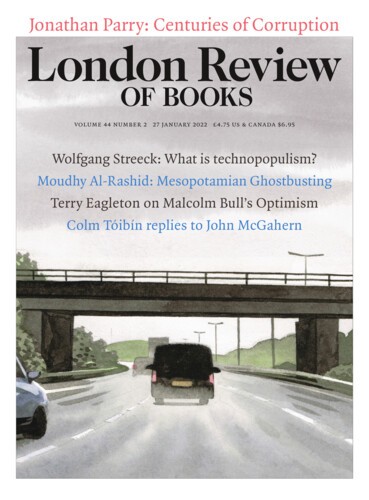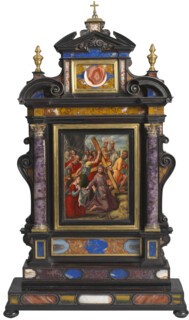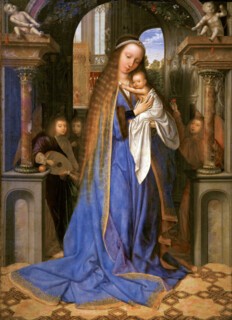When the Courtauld Institute of Art moved in 1989 from a house designed by Robert Adam in Portman Square to a wing of Somerset House, William Chambers’s masterpiece, it seemed a very satisfactory solution, especially because it provided an opportunity for the Courtauld Gallery to join the institute in its new premises. But whether the paintings could be happily accommodated in the ‘fine rooms’ Chambers had designed for the Learned Societies, and whether good use could be made of the Great Room, the large top-lit space devised by him for the annual exhibitions of the Royal Academy, was by no means certain and the ensuing compromises were often lamented.
An architectural campaign over the last three years has resulted in discreet and ingenious improvements: changes to the layout of the gallery; slopes for wheelchairs; some new, if modest, spaces, for classes and displays; also the removal of clutter from the entrance hall – although now that everything is clear and clean the many layers of paint clogging the once crisply defined plaster ornament are more apparent than ever. Starting at the top of the building, which will be the chief destination of most visitors, we find Samuel Courtauld’s Impressionist and Post-Impressionist paintings gathered in the Great Room and its antechamber. If some of the intimacy of a more domestic setting such as the artists anticipated has been sacrificed, the numerous connections between the works are now possible to appreciate. Walls built within the Great Room partially divide the space, allowing vistas and surprises which ensure, for example, prominence for A Bar at the Folies-Bergère and yet allow us to look across the room from Monet’s pine trees at Antibes to those painted at around the same time by Cézanne to frame a view of Montagne Sainte-Victoire.
The art of hanging paintings is little acknowledged, even by art historians, but has consequences that can equal the most eloquent criticism. When to defer to – and when to deviate from – expectation involves fine judgment and sensitivity. I would have predicted that the proximity of paintings by Van Gogh to those by Seurat would be fatal, but here it reminds us of Van Gogh’s creative adaptation of divisionism. Also remarkable is the way the definition of a pastel by Degas of a woman bathing gains in sharpness when placed beside Renoir’s portrait of Ambroise Vollard holding a small terracotta nude.
Adjacent to the Great Room are spaces that will be devoted to temporary loan exhibitions and to rotating displays from the Courtauld’s own modern holdings. At present they are occupied by the Karshan gift of modern drawings and by the paintings that Antoine Seilern (donor of many great Old Master paintings and drawings) commissioned from Oskar Kokoschka. Under its current director the gallery has mounted small exhibitions (Bruegel, Soutine, Lanyon) that will be remembered long after larger shows at other London institutions.
Also on this floor is a small room devoted to Bloomsbury with objects from the Omega Workshops. Roger Fry’s portrait of Nina Hamnett might be supposed to have inspired the colour scheme. Hamnett’s crossed legs establish a rhythm that is continued – and her cropped hair provides a shape that is echoed – in the pots and pans on the circular table behind her. The curve of a raised eyebrow contributes character and drama as it completes a pattern. Fry was the leading British writer on art in the period when Samuel Courtauld was acquiring his collection of modern French paintings and this portrait obviously owes something to Cézanne, but it also explains Fry’s enthusiasm for African art, illustrated here by a reliquary figure from Gabon that he owned.
For some avant-garde artists, such art appealed because it was thought to be savage, thus reinforcing earlier ethnographic categories, but Fry was attracted by the formal qualities of this work. If a lack of interest in its ritual purpose is to be regarded as ‘racist’, as the label proposes, then we should also remember that Fry urged us to disregard the subject matter of Raphael’s Transfiguration. Primitivism was a complex phenomenon and the word ‘primitive’ was used in many positive contexts, as Caroline Elam explains with great clarity in her recent book, Roger Fry and Italian Art (Ad Illisum, £100).
Descending to the mezzanine floor we can admire paintings that were known for well over a century as Italian Primitives, about which, as Elam demonstrates, Fry wrote with great insight. These late medieval and early Renaissance works were previously displayed in a ground floor room that was easily missed by visitors. Now they are to be seen near the drawings gallery in a room with a low ceiling in which the lighting elicits just the right amount of glitter on the tooled gilding of the backgrounds, giving an appropriate emphasis to the precious and intricate as well as intimate character of many of these works – an emphasis that is reinforced by juxtaposition with an enamelled pax, ivory diptychs, and chased and inlaid Islamic metalwork.
Ascending to the next floor, we enter the ‘fine rooms’, which retain much of their original ornament. In each of them the paintings are accompanied by objects. In the one devoted to Northern Renaissance art, the little painting by Pieter Aertsen is displayed in a hardstone tabernacle that Seilern found for it. Amethyst columns, as the label notes, were selected to match the purple in the painting. By placing the painting by Quinten Massys behind the tabernacle, the curators promote awareness of the semi-translucent bloodstone columns framing the Virgin and Child in the painting itself.
As we leave that room we are drawn into Pieter Bruegel the Elder’s Landscape with the Flight into Egypt, in which the marvellous panorama is also a laborious prospect and the varied forms of the rocks are full of dangers. In the next room we first encounter, in a case, the tiny painting of a sunset on copper by Claude which is made so much more than beautiful by the lone rider who travels within this great space. The idea of a journey, and especially of early departure and late arrival, was never far from the mind of this painter. Some of the other small paintings here are records of larger ones; others are preparatory works. On the walls are great oil sketches by Rubens, including two of a subject that was well suited to his talents: Saul blinded by divine light and hurled from his mount. Figures and horses and drapery form an astonishing compositional tornado.
Then on to the 18th century, to Reynolds and Goya and Tiepolo. It is unsurprising that the 18th-century silver (much of it made by Samuel Courtauld’s ancestors) and the beautiful clock case designed by Chambers look so well here, but the impact of Gainsborough’s portrait of his wife is quite unexpected: the blue panel provides a foil for the black veil around which her hands flutter, and the hovering smile – a little ironic but not unkindly so – is accompanied by candid eyes of a colour that matches the grey of the room’s walls.
We can then continue back to the top floor up the elegant staircase. On the curved wall beneath the lantern there is a tripartite painting commissioned by the gallery from Cecily Brown. From the turmoil of flurried brushstrokes to right and left, recollections or premonitions of flesh emerge, and in the centre nude men bravely advance towards the incomparable paintings in the Great Room. It may be a primordial scene, but it is also a testimony to the primitive power of painting and to the modern artist’s view of where painting began.
Send Letters To:
The Editor
London Review of Books,
28 Little Russell Street
London, WC1A 2HN
letters@lrb.co.uk
Please include name, address, and a telephone number.



